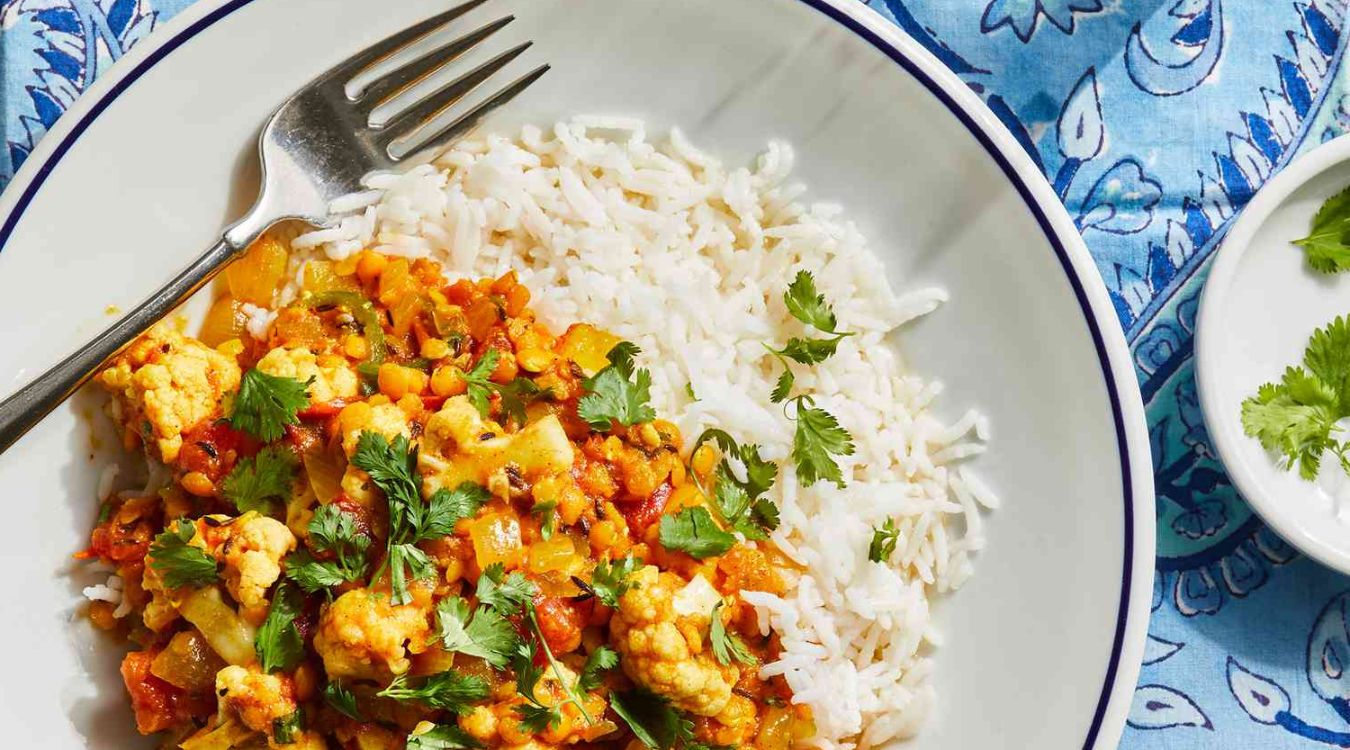Dive into the rich and aromatic world of vegan Indian cuisine with this delightful curry. Combining the hearty textures of cauliflower and lentils with the creamy goodness of coconut milk, this dish is both satisfying and nutritious. Perfect for a cozy dinner, this curry is sure to become a favorite in your household.
Some ingredients in this recipe might not be staples in every kitchen. Red lentils are a key component and can usually be found in the dried beans section of the supermarket. Full-fat coconut milk is essential for the creamy texture and is typically located in the international or baking aisle. Fresh ginger and cilantro can be found in the produce section, while curry powder, turmeric, and cumin are available in the spice aisle.

Ingredients For Vegan Indian Curry With Cauliflower And Lentils
Cauliflower: A versatile vegetable that absorbs the flavors of the curry beautifully.
Red lentils: These cook quickly and add a lovely texture and protein to the dish.
Coconut milk: Provides a rich and creamy base for the curry.
Onion: Adds a sweet and savory depth to the curry.
Garlic: Enhances the flavor with its pungent aroma.
Ginger: Adds a fresh, zesty kick to the curry.
Curry powder: A blend of spices that gives the curry its distinctive flavor.
Turmeric: Adds a warm, earthy flavor and vibrant color.
Cumin: Provides a nutty, peppery taste that complements the other spices.
Salt: Enhances all the flavors in the dish.
Vegetable broth: Adds depth and helps cook the lentils and cauliflower.
Olive oil: Used for sautéing the onions, garlic, and ginger.
Frozen peas: Adds a pop of color and sweetness to the curry.
Cilantro: Fresh herb used for garnish, adding a burst of freshness.
Technique Tip for This Recipe
When cooking the onion, make sure to cook it until it is fully translucent and slightly caramelized. This will add a depth of flavor to the curry that enhances the overall dish. Additionally, when adding the spices like curry powder, turmeric, and cumin, toast them in the olive oil for about a minute to release their essential oils and intensify their flavors. This step is crucial for achieving a rich and aromatic base for your vegan curry.
Suggested Side Dishes
Alternative Ingredients
cauliflower - Substitute with broccoli: Broccoli has a similar texture and can absorb the flavors of the curry well.
red lentils - Substitute with yellow lentils: Yellow lentils cook similarly and have a comparable taste and texture.
full-fat coconut milk - Substitute with cashew cream: Cashew cream provides a similar creamy texture and richness without the coconut flavor.
onion - Substitute with shallots: Shallots offer a milder and slightly sweeter flavor that can complement the curry.
garlic - Substitute with garlic powder: Garlic powder can provide a similar flavor, though it is less pungent.
ginger - Substitute with ground ginger: Ground ginger can be used in a smaller quantity to provide a similar warmth and spiciness.
curry powder - Substitute with garam masala: Garam masala offers a different but complementary spice profile that works well in curries.
turmeric - Substitute with saffron: Saffron can provide a similar color and a unique flavor, though it is more expensive.
cumin - Substitute with caraway seeds: Caraway seeds have a similar earthy flavor that can mimic cumin in recipes.
salt - Substitute with soy sauce: Soy sauce can add a salty and umami flavor, though it will also add a bit of liquid.
vegetable broth - Substitute with water with bouillon cubes: Bouillon cubes dissolved in water can provide a similar depth of flavor as vegetable broth.
olive oil - Substitute with coconut oil: Coconut oil can add a subtle coconut flavor and has a similar cooking profile.
frozen peas - Substitute with green beans: Green beans can provide a similar color and a slightly different but complementary texture.
cilantro - Substitute with parsley: Parsley can provide a fresh, herbaceous note similar to cilantro without the soapy taste some people perceive.
Other Alternative Recipes Similar to This Curry
How To Store / Freeze This Curry
Allow the curry to cool completely before storing. This prevents condensation, which can make the curry watery and affect its texture.
Transfer the cooled curry into airtight containers. For portion control and convenience, consider using individual serving-sized containers.
Store the containers in the refrigerator if you plan to consume the curry within 3-4 days. Ensure the containers are sealed tightly to maintain freshness and prevent any odors from the curry from permeating your fridge.
For longer storage, place the airtight containers in the freezer. The curry can be frozen for up to 3 months without significant loss of flavor or texture.
When ready to reheat, thaw the curry in the refrigerator overnight if frozen. This gradual thawing helps maintain the integrity of the cauliflower and lentils.
Reheat the curry on the stovetop over medium heat, stirring occasionally to ensure even heating. You may need to add a splash of vegetable broth or coconut milk to restore the desired consistency.
Alternatively, you can reheat individual portions in the microwave. Use a microwave-safe dish, cover it loosely to avoid splatters, and heat in 1-minute intervals, stirring in between until heated through.
Garnish with fresh cilantro just before serving to revive the vibrant flavors and add a touch of freshness to the reheated curry.
If you notice any changes in smell, color, or texture, it’s best to discard the curry to ensure food safety.
How To Reheat Leftovers
For stovetop reheating, pour the leftover vegan curry into a saucepan. Add a splash of vegetable broth or coconut milk to maintain its creamy consistency. Heat over medium-low, stirring occasionally until warmed through. This method helps retain the texture of the cauliflower and lentils.
To reheat in the microwave, transfer the curry to a microwave-safe dish. Cover with a microwave-safe lid or wrap to prevent splatters. Heat on medium power for 2-3 minutes, stirring halfway through. If needed, add a bit of vegetable broth or coconut milk to keep it from drying out.
For oven reheating, preheat your oven to 350°F (175°C). Place the curry in an oven-safe dish, cover with aluminum foil to keep it moist, and bake for about 20 minutes or until heated through. This method is great if you're reheating a large batch.
If you have a slow cooker, transfer the curry to the slow cooker and set it on low for 1-2 hours. This is a hands-off method that ensures even heating without the risk of burning.
For a quick reheat, use a steamer. Place the curry in a heatproof bowl and set it in a steamer basket over boiling water. Cover and steam for about 10 minutes. This method helps maintain the integrity of the vegetables and lentils.
If you have an Instant Pot, use the sauté function. Add the curry to the pot, set to sauté on low, and stir occasionally until heated through. This method is quick and efficient, especially if you already have your Instant Pot out.
Best Tools for Making This Indian Curry
Large pot: Used for cooking the curry and ensuring all ingredients are well combined and cooked evenly.
Olive oil: Used for sautéing the onions, garlic, and ginger to build the base flavors of the curry.
Chopping board: Essential for chopping the onion, garlic, ginger, and cilantro.
Chef's knife: Used for chopping the vegetables and herbs.
Measuring cups: Used for measuring the red lentils, coconut milk, and vegetable broth accurately.
Measuring spoons: Used for measuring the curry powder, turmeric, cumin, and salt.
Wooden spoon: Ideal for stirring the curry as it cooks.
Grater: Used for grating the ginger.
Can opener: Used for opening the can of coconut milk.
Colander: Used for rinsing the red lentils.
Serving spoon: Used for serving the curry once it is ready.
Ladle: Useful for portioning out the curry into bowls.
Bowl: Used for holding the chopped cilantro for garnish.
How to Save Time on Making This Curry
Prep ingredients in advance: Chop the onion, garlic, and ginger ahead of time and store them in airtight containers.
Use pre-cut cauliflower: Buy cauliflower florets that are already cut to save chopping time.
Rinse lentils early: Rinse the red lentils and let them drain while you prep other ingredients.
Measure spices beforehand: Measure out the curry powder, turmeric, and cumin into a small bowl so they’re ready to add.
Frozen peas convenience: Use frozen peas directly from the freezer without thawing.
Batch cook: Make a larger batch of the curry and freeze portions for quick meals later.

Vegan Indian Curry with Cauliflower and Lentils
Ingredients
Main Ingredients
- 1 head Cauliflower cut into florets
- 1 cup Red Lentils rinsed
- 1 can Coconut Milk full-fat
- 1 large Onion chopped
- 3 cloves Garlic minced
- 1 tablespoon Ginger grated
- 2 tablespoon Curry Powder
- 1 teaspoon Turmeric
- 1 teaspoon Cumin
- 1 teaspoon Salt or to taste
- 2 cups Vegetable Broth
- 2 tablespoon Olive Oil
- 1 cup Frozen Peas
- 1 bunch Cilantro chopped, for garnish
Instructions
- Heat the olive oil in a large pot over medium heat. Add the chopped onion and cook until translucent.
- Add the minced garlic and grated ginger, cook for another 2 minutes.
- Stir in the curry powder, turmeric, and cumin. Cook for 1 minute until fragrant.
- Add the cauliflower florets, red lentils, vegetable broth, and coconut milk. Bring to a boil, then reduce heat and simmer for 20 minutes.
- Add the frozen peas and cook for another 5 minutes.
- Season with salt to taste. Garnish with chopped cilantro before serving.
Nutritional Value
Keywords
Suggested Appetizers and Desserts for This Curry
More Amazing Recipes to Try 🙂
- Indian Chana Saag Recipe45 Minutes
- Small Batch Blueberry Jam Recipe40 Minutes
- Indian Masala Bhindi Fry Recipe35 Minutes
- Indian Vada Curry Recipe1 Hours 10 Minutes
- Cream Cheese Frosting Recipe10 Minutes
- Baked Indian Samosas Recipe55 Minutes
- Indian Okra and Tomato Stir Fry Recipe30 Minutes
- Indian Pizza Recipe35 Minutes

Leave a Reply